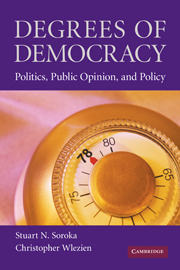Book contents
- Frontmatter
- Contents
- Preface
- Degrees of Democracy
- 1 Public Opinion and Policy in Representative Democracy
- 2 The Thermostatic Model
- 3 Adding Issues and Institutions
- 4 Public Preferences and Spending
- 5 Parameters of Public Responsiveness
- 6 Public Responsiveness Explored
- 7 Policy Representation
- 8 Disaggregating Public Responsiveness and Policy Representation
- 9 Degrees of Democracy
- Appendix
- Bibliography
- Index
2 - The Thermostatic Model
Published online by Cambridge University Press: 05 June 2012
- Frontmatter
- Contents
- Preface
- Degrees of Democracy
- 1 Public Opinion and Policy in Representative Democracy
- 2 The Thermostatic Model
- 3 Adding Issues and Institutions
- 4 Public Preferences and Spending
- 5 Parameters of Public Responsiveness
- 6 Public Responsiveness Explored
- 7 Policy Representation
- 8 Disaggregating Public Responsiveness and Policy Representation
- 9 Degrees of Democracy
- Appendix
- Bibliography
- Index
Summary
Imagine a time series of public preferences for policy in a particular area. Let us assume that we have regular annual readings of public preferences. To keep things simple, let us assume further that our readings are perfect; in other words, that there is no bias or sampling error. What happens when public preferences change? What are the consequences for policy? To what extent do changing policies then affect preferences? Our expectations are captured in a general model of opinion-policy dynamics.
THE MECHANICS OF PUBLIC RESPONSIVENESS
The representation of public opinion presupposes that the public actually notices and responds to what policymakers do. It means that the public must acquire and process information about policy, and adjust its preferences accordingly. As we have noted, without such responsiveness, policymakers would have little incentive to represent what the public wants in policy – without public responsiveness, expressed public preferences would contain little meaningful information. There not only would be a limited basis for holding politicians accountable; registered preferences would be of little use even to those politicians motivated to represent the public for other reasons.
A responsive public will behave much like a thermostat (Wlezien 1995), adjusting its preferences for “more” or “less” policy in response to what policymakers do. When policy increases (decreases), the preference for more policy will decrease (increase), other things being equal. Consider the public as a collection of individuals distributed along a dimension of preference for policy activity, say, spending on defense.
- Type
- Chapter
- Information
- Degrees of DemocracyPolitics, Public Opinion, and Policy, pp. 22 - 42Publisher: Cambridge University PressPrint publication year: 2009



